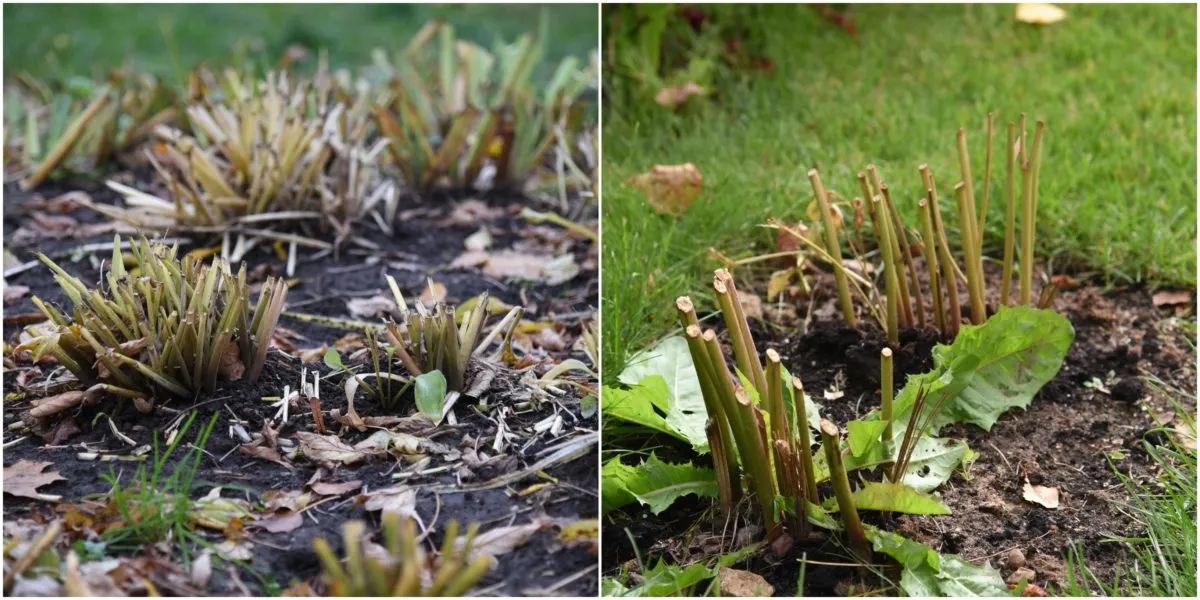
Over the past decade, the advice on the best time to cut back perennials has been noticeably shifting.
Thankfully, our increased awareness of the fact that we need to protect pollinators is leading more and more people towards a nature-friendly style of gardening. And deferring pruning until spring is just one of the ways in which we can turn our gardens into safe havens for beneficial insects.
We talked about the main reasons why you should prune in spring and about the plants that should leave standing over winter in this post.
But there are some perennials that can (and often should) be pruned hard in the fall.
Cutting back in fall is needed in order to promote plant health and remove the unwanted diseases and pests that may take over these plants in the winter. After all, taking care of the plants you already have and not treating them as disposable is very much in line with the sustainable gardening ethos.
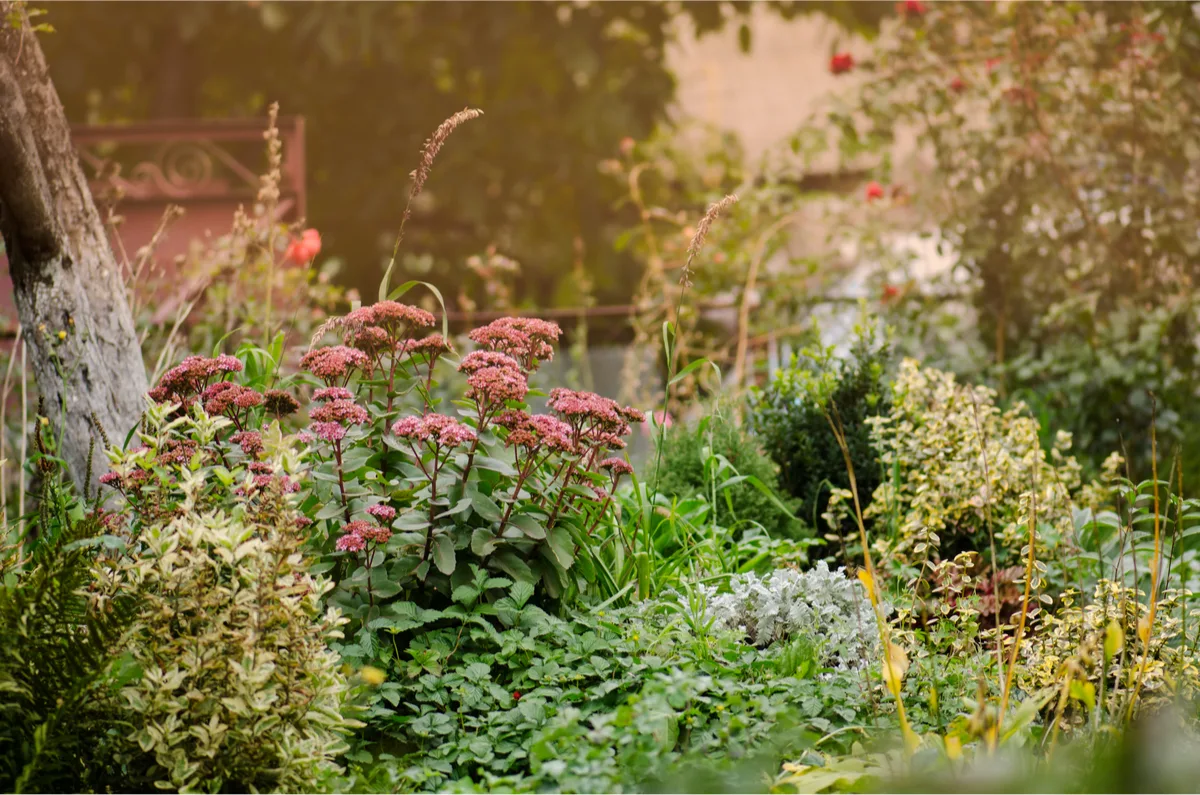
What perennials should I cut back in the fall?
Below, I’ve written a list of the most popular perennials that will benefit from a fall pruning. For all of these plants, trimming them down at the end of the growing season is better than letting them overwinter with their foliage attached.
In general, you should cut down perennials in the fall in the following scenarios:
Your perennials are suffering from fungal diseases.
Fungal diseases, such as the dreaded powdery mildew, can attack at any point in the growing season. However, with the advent of fall, when we get more rainfall and less sun than during the long days of summer, it gets harder to keep mildew under control. Fungi will quickly colonize dying foliage and will happily overwinter until next year.
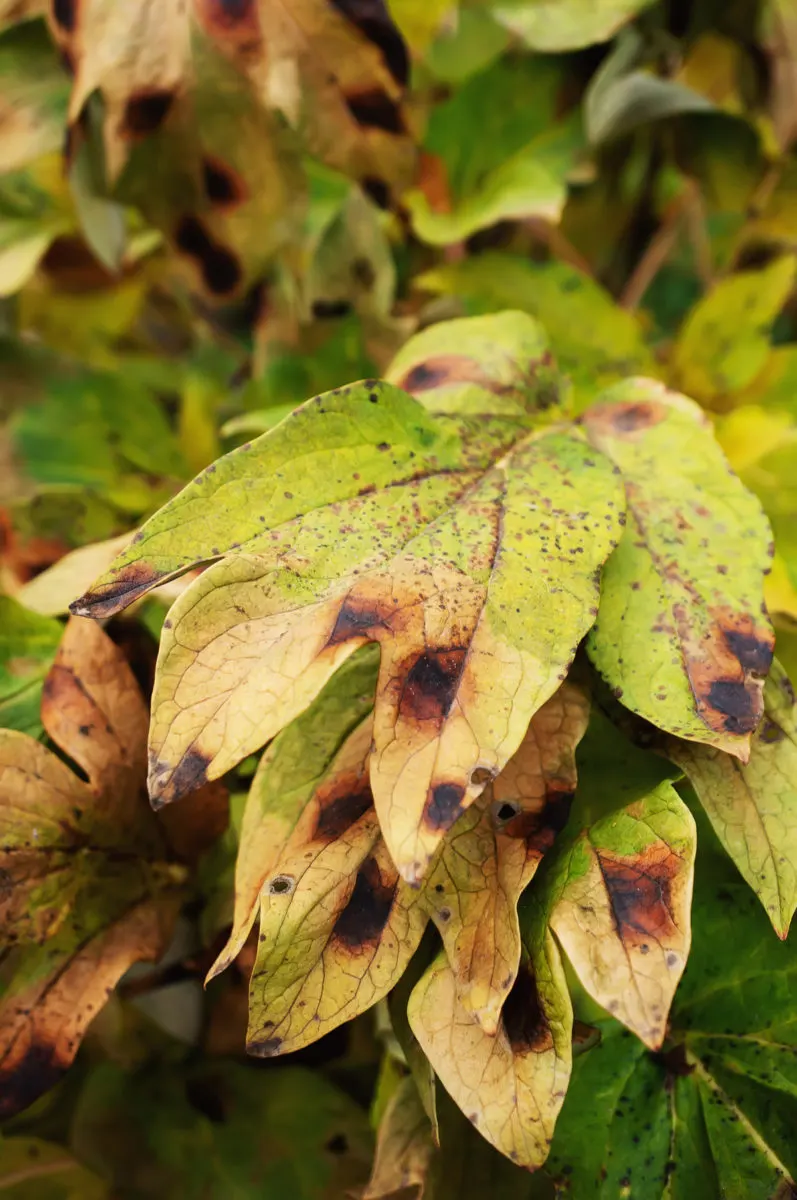
If your plant has been affected by mildew, then you need to cut it down to the ground and dispose of the leaves in the trash. Don’t compost sick foliage. And remember to always sterilize your tools when you’re done with this messy gardening job.
Your perennials are being devoured by pests.
Just like fungi, pests can have a field day on plants that are already on their way out at the end of the growing season. Snails and slugs are the most common culprits in most gardens, and they can get unmanageable on chilly wet days. Slugs will chew through the foliage of some perennials until there isn’t much left, and they’ll deposit their eggs at the base of the plant or in damp and dark places underneath garden debris.
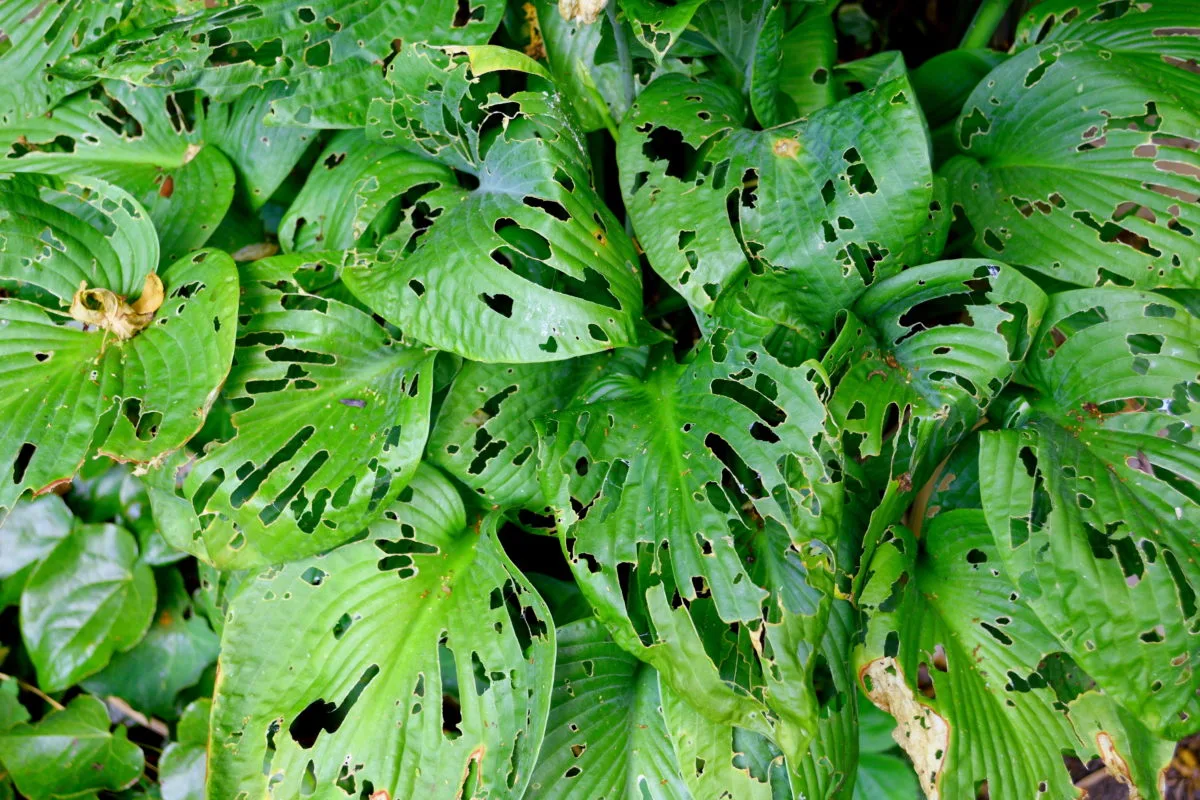
Perennials such as hostas are an absolute delicacy for slugs. So trimming these plants down will allow you to keep the site around them tidy and clean up any slug eggs that would otherwise turn your next gardening season into a frustrating affair.
Your perennials turn soft and slimy after a frost.
Not all perennials are created equal when it comes to how the foliage reacts to hard frost. Some fibrous plants will turn dry and crunchy. That’s why plants such as globe thistle and black-eyed Susan make for a wonderful winter decor in the garden.
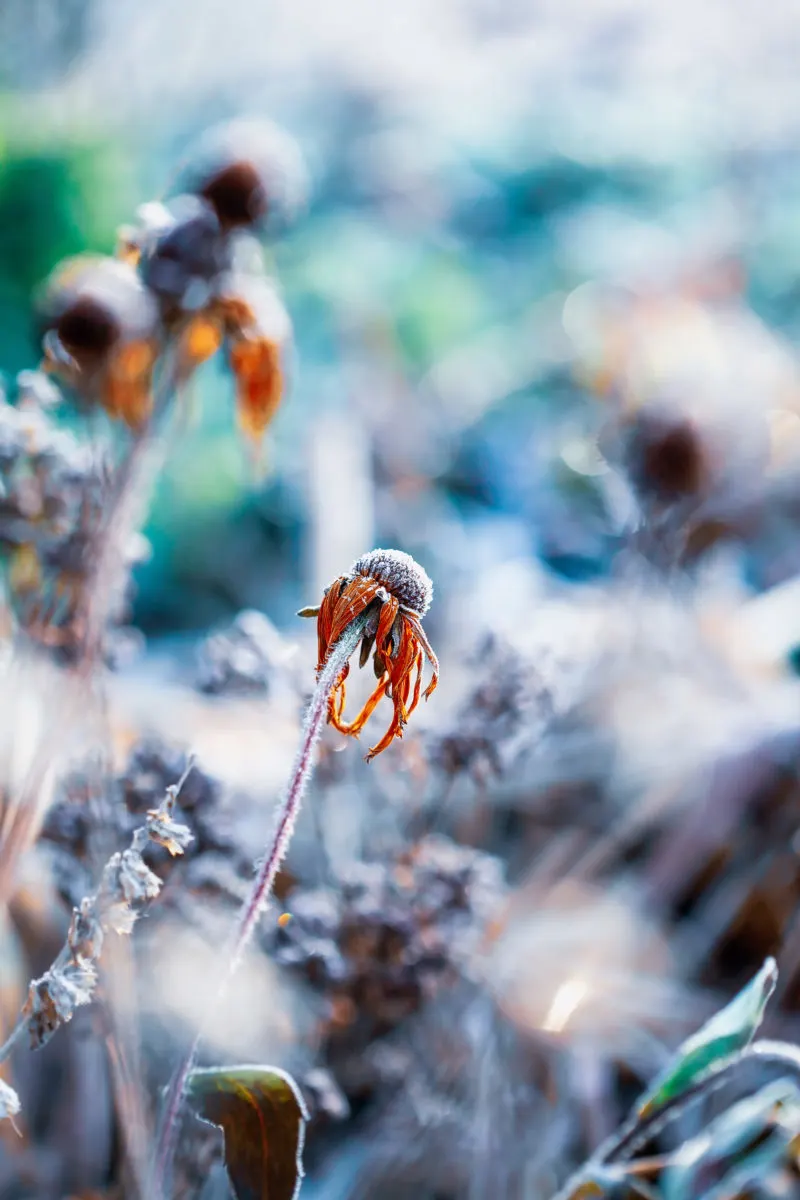
However, the leaves of other perennials, such as daylilies and ligularia, will turn soft and mushy when the frost sets in. This renders the foliage useless in terms of protecting the crown and the roots from the cold. It can also have the undesired side-effect of harboring fungi and bacteria that thrive in a dark and moist environment.
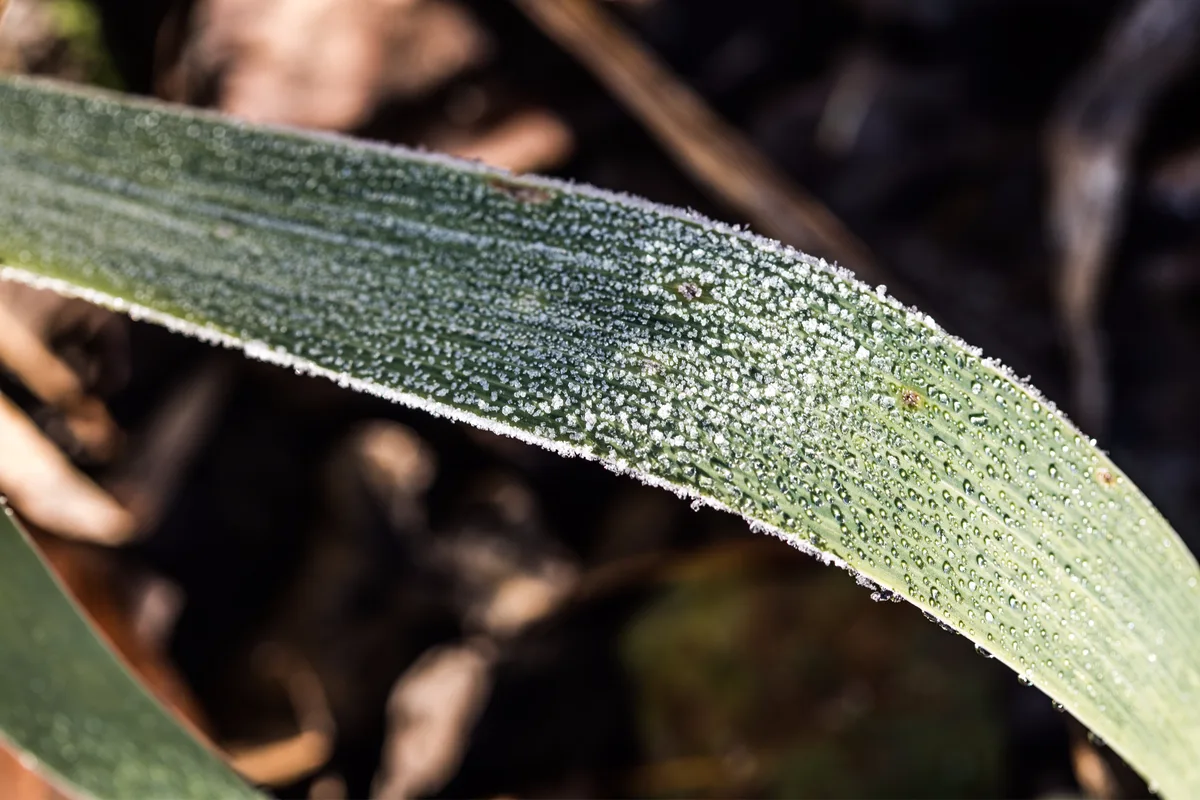
When should I cut back perennials in the fall?
It’s understandable that when the weather gets cold and the days get shorter, you want to put your garden to bed for the winter as early as possible. After all, not everyone enjoys being outside in the garden trimming slimy foliage after the first frost hits.
However, keep in mind that plants also go through their own process of preparing for winter. They use the leaves to photosynthesize and gather energy to make it through the winter. If you cut off their foliage too soon, you’re cutting off one of their energy sources, so your plants may grow weak and spindly the following spring.
If you can muster up the patience, wait until a few rounds of hard frost have passed before you trim back, just to make sure that your perennials have really gone dormant.
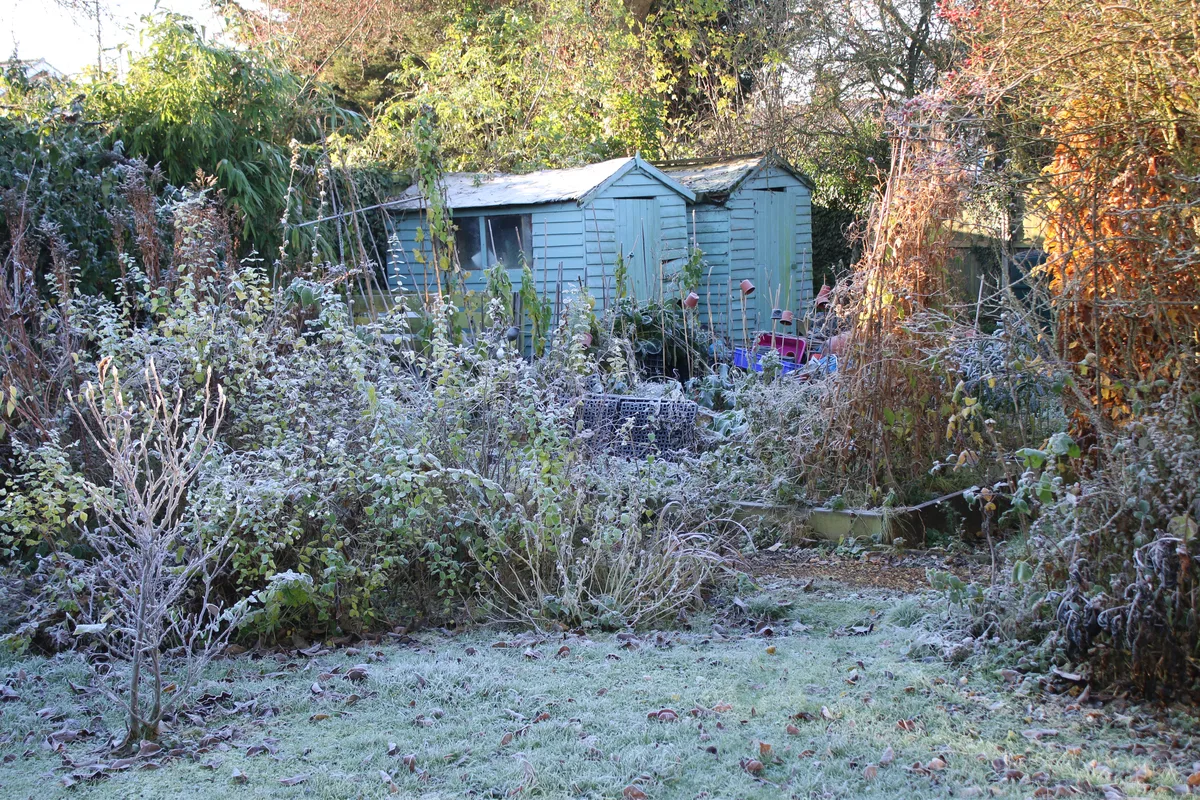
And here’s a bonus tip from my own experience. As soon as you prune down your perennials in the fall, stick a tag in the ground next to the remaining stem stubs with the name of the plant. Add the variety (or cultivar) if you know it and the expected timing of its comeback next spring.
This will come in handy if you have a large garden, if you’ve recently expanded your plant repertoire or – and this very much applies to myself – if you just have a bad memory. You’ll be less likely to disturb the plant roots or accidentally dig them out in a fit of spring cleaning. And you’ll be less likely to find yourself puzzled about what on earth is sprouting out of the ground come March. (Again, I’m speaking from experience here.)
What perennials should I cut back in the fall?
Here are 12 perennials that could do with a good fall cleanup:
1. Daylilies (Hemerocallis)
Depending on what cultivar you’re growing and what zone you’re gardening in, your daylilies could be in bloom from May until September.
In milder climates, daylily foliage will hold its shape and overwinter in place, while in colder climates it will turn yellow and look bedraggled as early as October. It’s better to let daylilies die back on their own, and only then intervene by pruning off the dead leaves at about four to six inches above the crown.
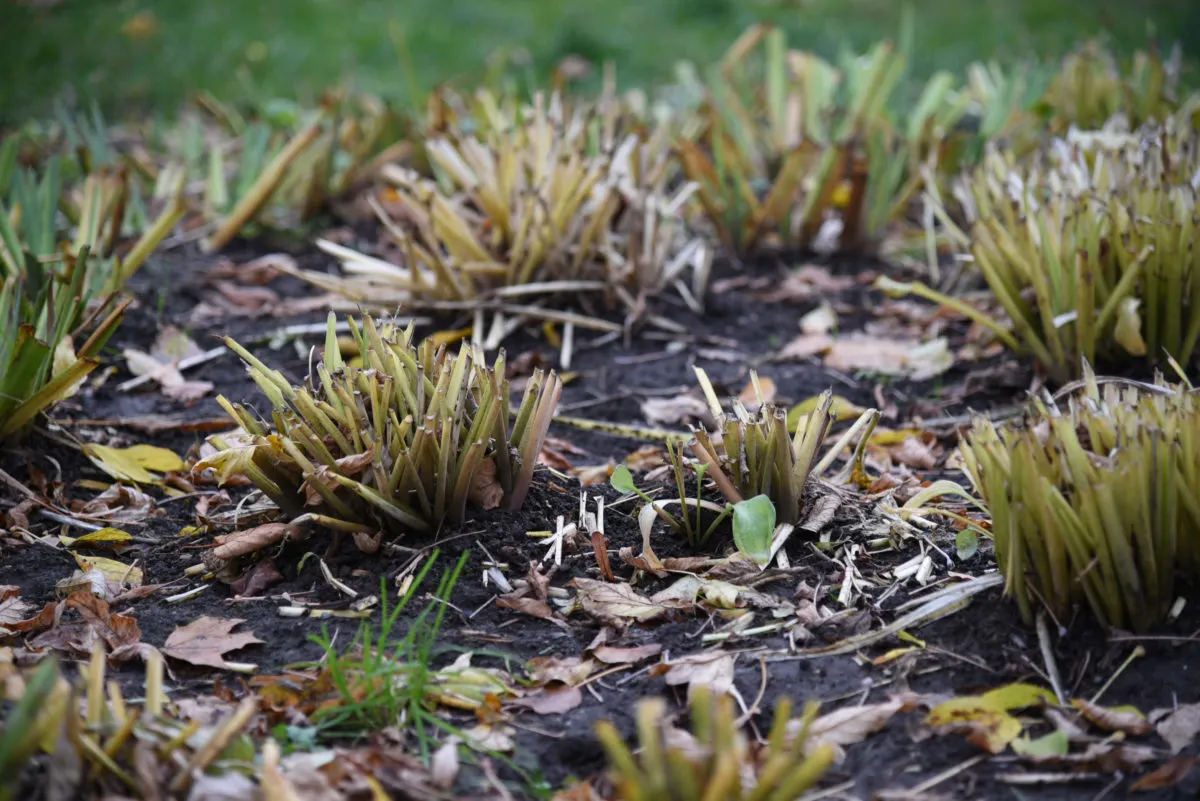
Because daylilies use up a lot of energy to bloom, their foliage may wilt or dry out throughout the summer. You can tidy up dead foliage all through the year, but wait until mid-fall to do a more serious pruning.
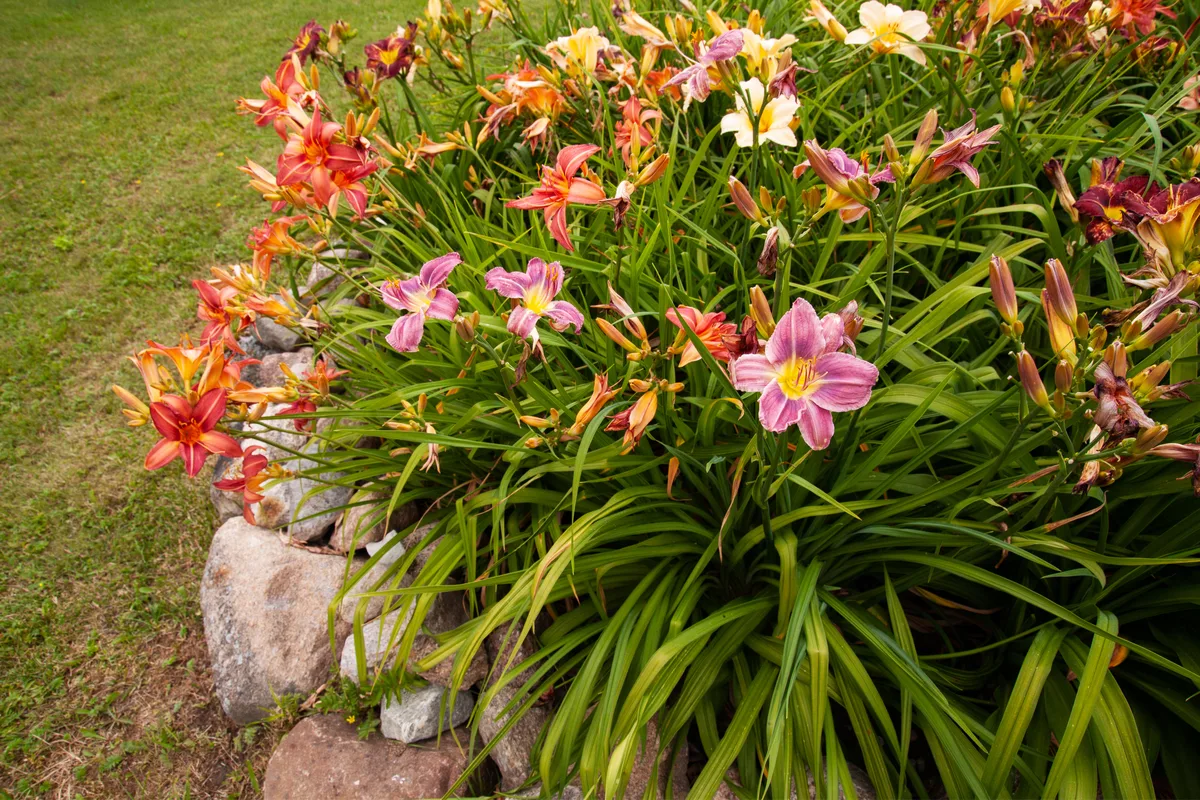
When the temperatures drop below freezing, daylilies get mushy, which makes cleaning them up unpleasant, but not impossible. Depending on when your first frost is expected, you can preempt this by pruning daylilies a few days beforehand.
Daylilies are one of those plants that don’t like to be crowded. They need to be divided every few years in order to keep putting out a rich display of blooms. By pruning daylilies in the fall, you’ll make it easier on yourself to divide them when spring comes around.
2. Hostas
Damaged hosta leaves that have been turned into lace by slugs are a sad sight in the summer garden. The same slugs that attack it throughout the growing season will be more than happy to use it as a maternity ward in the fall. Dead hosta foliage makes for a hospitable environment for slug eggs that will overwinter in comfort and wreak havoc on your greenery next year.
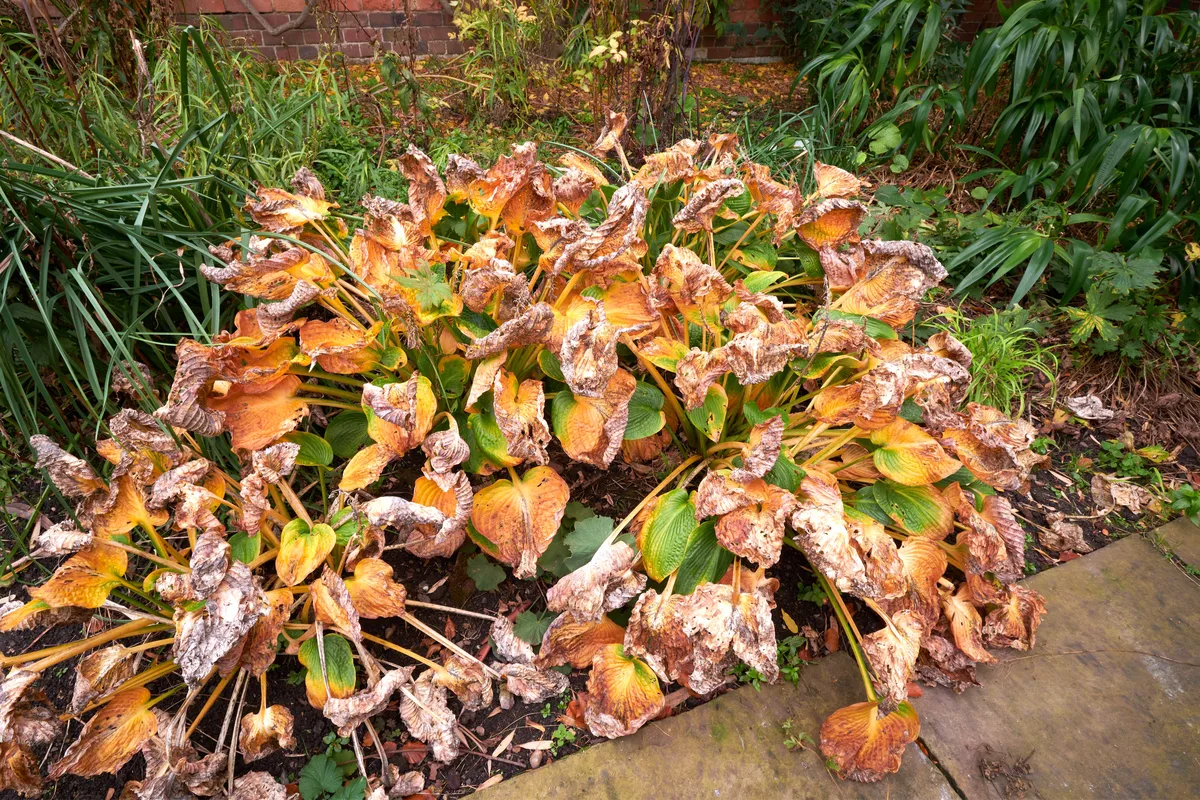
Trim your hostas down to about three inches above the crown. You can wait for the first frost or do it as soon as the leaves have turned brown (or whichever comes first). While you’re at it, manually inspect the plant and remove any sign of slugs and their eggs.
When you prune your hosta, pick up any leaves that may have fallen on the ground. You can compost them, as long as you don’t find any intruders lurking.
3. Bearded irises
Some gardeners cut down the leaves of their bearded irises as soon as the blooms have faded in the summer. This is one piece of popular gardening advice that we don’t recommend.
Quite the opposite. You should leave the foliage on all throughout the summer because it’s the main way for the iris rhizome to gather the energy it needs to overwinter and produce flowers next spring. In fact, premature pruning may lead to your iris not blooming the following season.
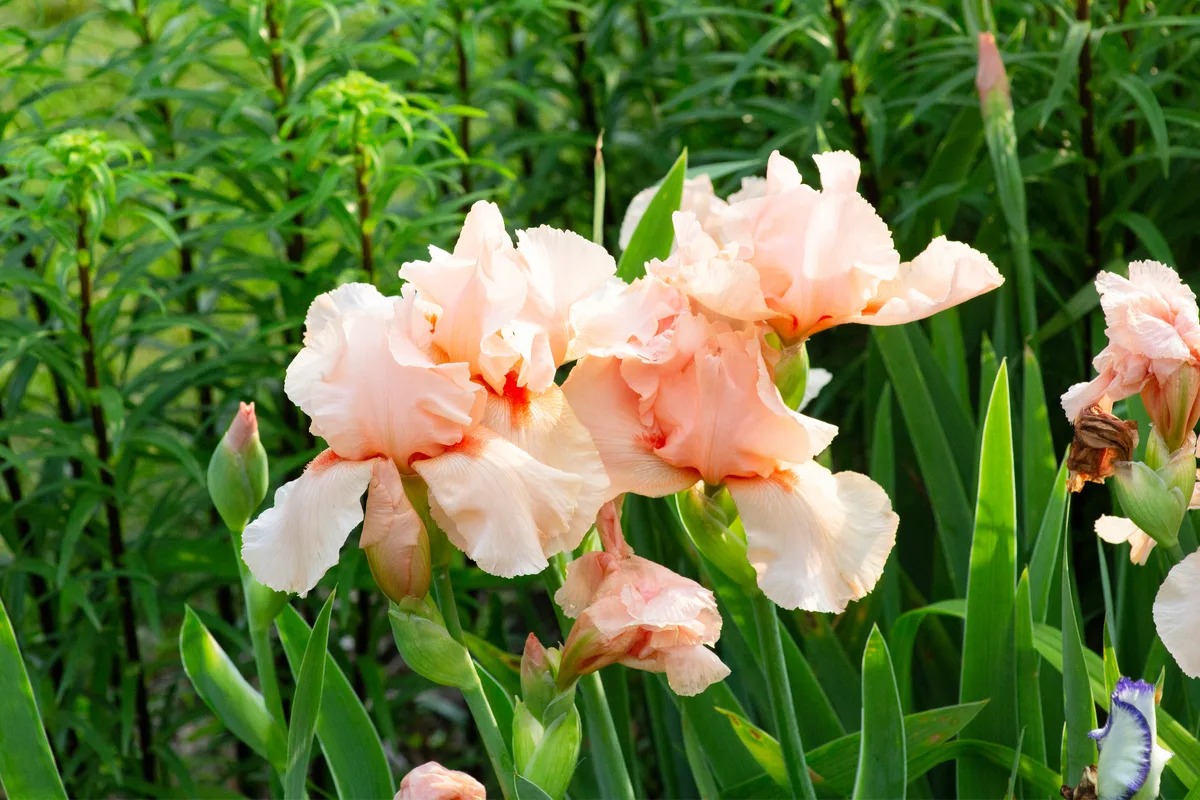
Your iris is ready for pruning after the first frost when the foliage has wilted and turned brown. Pruning your iris in the fall is necessary to keep it disease-free because of the dreaded iris borer – a caterpillar that chews through the leaves and all the way down into the rhizome, destroying it from the inside out.
The iris borer deposits its eggs underneath the foliage and at the base of the iris stem, so giving the plant a good cleanup in the fall reduces the chances of it harboring this pest through the winter.
The most visually attractive way to prune the leaves of the iris is into the shape of a fan, following the natural growth of the foliage. Cut the leaves down to about six inches from the crown and remove the dead foliage that may have fallen at the base of the plant.
Related Reading: How & When To Divide Iris
4. Peonies (Paeonia)
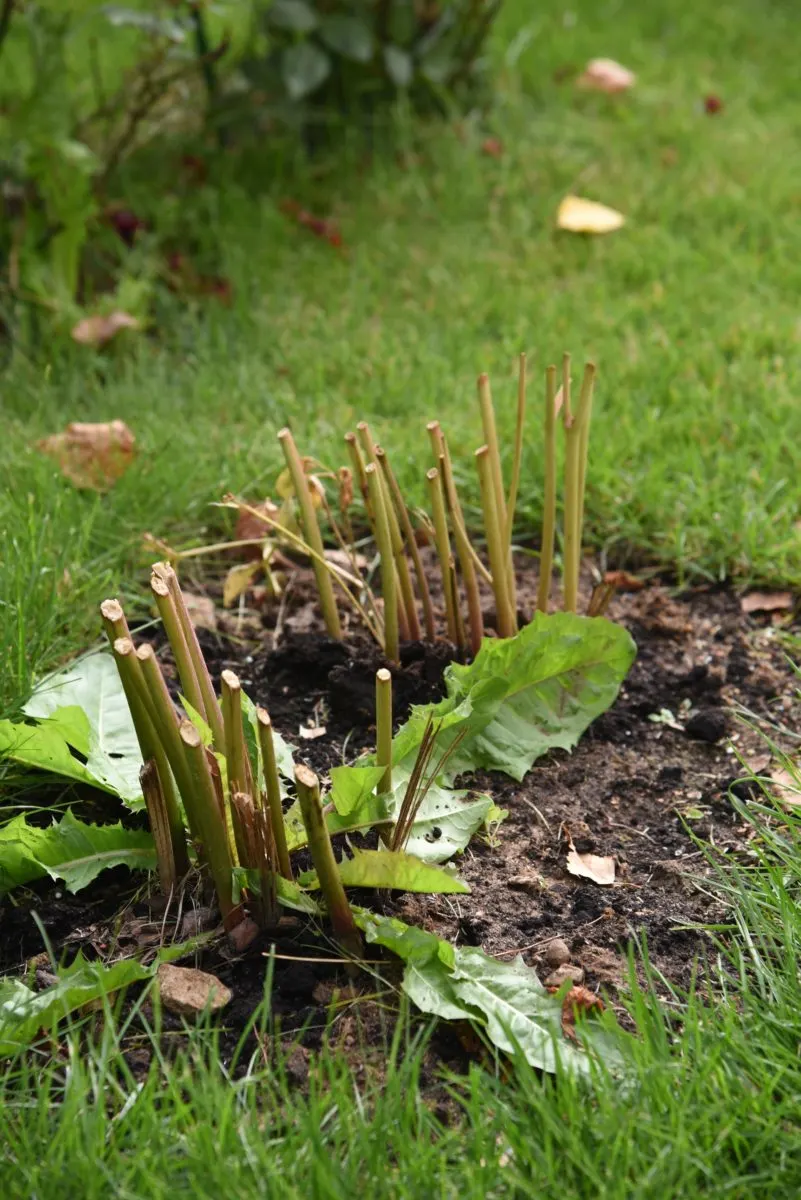
Just as with hostas, irises and daylilies, the texture of the dead peony foliage will make it harder to clean up in spring. Another reason to prune peonies in the fall is due to their susceptibility to powdery mildew and botrytis, a fungal disease that blackens the stems and may lead to your peonies not blooming.
You should remove any diseased plant material from the garden as soon as you spot it and dispose of it with your household waste. Do not compost mildewed leaves and make sure you sanitize your gardening shears as soon as you’re done pruning your peonies.
With peonies, you can wait until the leaves turn yellow or wait until the first frost has passed to trim if you like the look of yellow foliage in the fall.
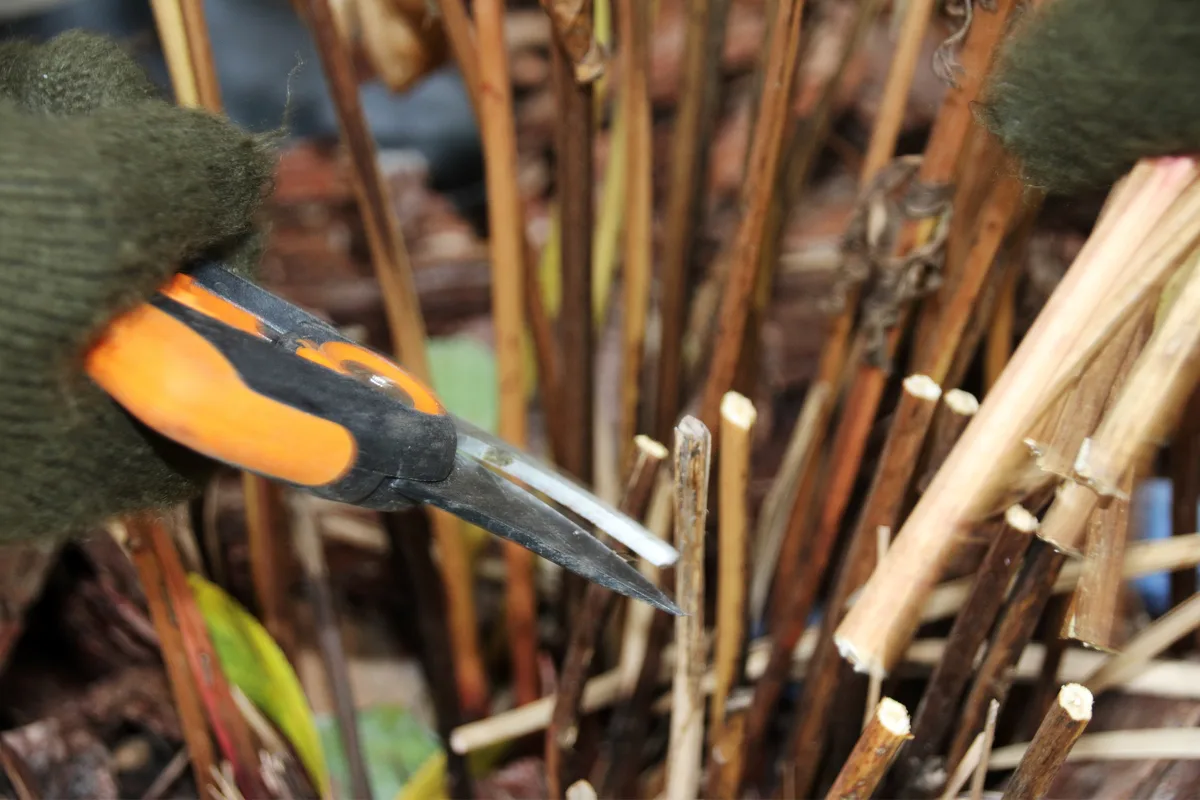
Gather the stems of the peonies a handful at a time and trim them off to about three inches above the level of the soil.
Some gardeners like to use the prunings to mulch around the plant, but we recommend you avoid this if your foliage hasn’t been one hundred percent healthy throughout the summer. You can mulch your peonies with bark or pine needles to protect the root structure from cold temperatures.
5. Bee balm (Monarda)
This colorful plant, very popular with pollinators all summer long, needs a bit of a trim in the fall in order to encourage new growth in the spring. Prune it down to about three to five inches above soil level to give it a boost to come back stronger next year.
Just like peonies and garden phlox, bee balm is susceptible to powdery mildew towards the end of the summer, especially if it’s in a location that doesn’t allow much air circulation. You can dispose of foliage that is showing signs of mildew as soon as you notice it, then dispose of the rest of the leaves in the fall.

Bee balm is one of those plants that should be divided every two to three years, otherwise it takes over its turf too fast to keep in check. Pruning it in the fall will allow you to divide it as soon as the first frost has passed the following spring. You should be deadheading the spent blooms all throughout the season to encourage the plant to put out an even more impressive display of flowers.
6. Columbine (Aquilegia)
Some gardeners will prune columbine halfway down the plant as soon as the bloom cycle has ended. And if you have the perfect conditions in your garden (mild climate, plenty of water and not too hot), this early summer pruning may encourage a second bloom the same year.
Once the second bloom is over, you can allow the plant to self-seed if you want your columbine patch to grow even bigger next year. And you should, since columbine is an early source of nectar for hummingbirds and moths.
You can also collect the seeds to share them with other gardeners or direct-sow them next spring or use them in container arrangements. And if you have several types of columbine in your garden, don’t be surprised if you get a new combination of hues, as columbines are very prone to cross-pollination.
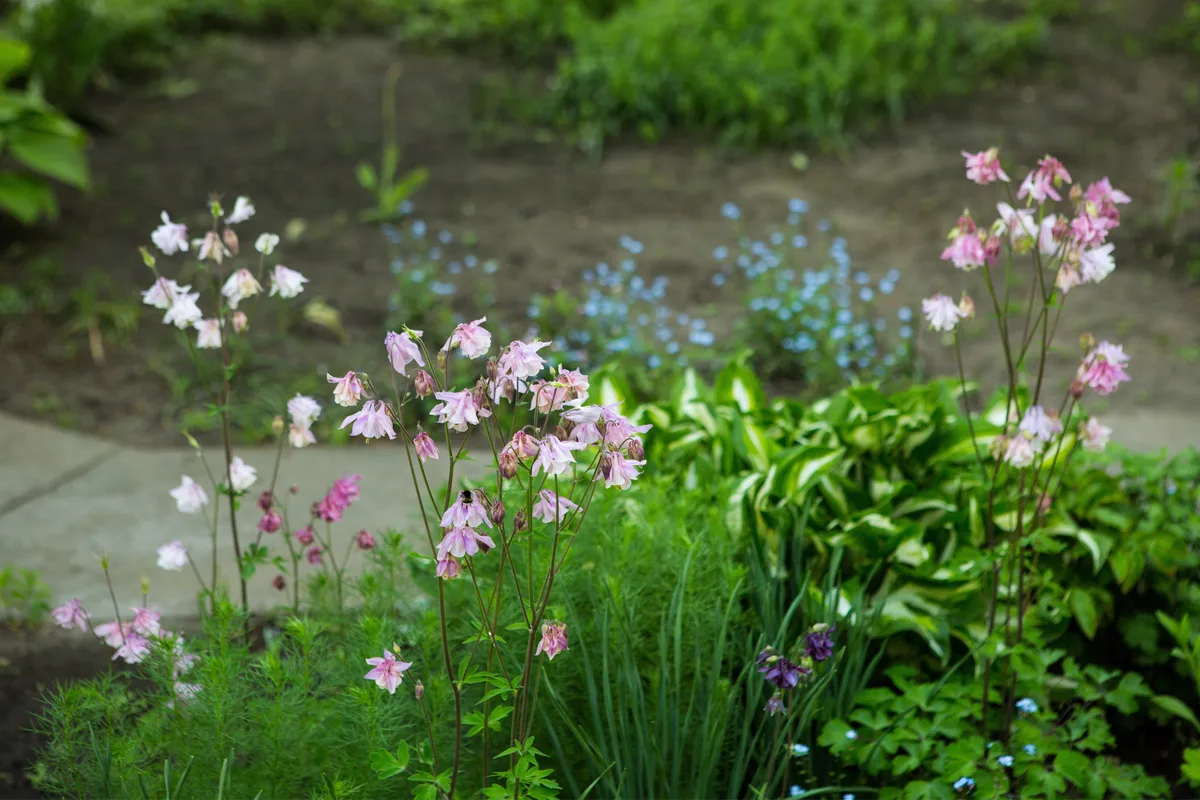
When your columbine is done blooming, usually by the end of July, the foliage starts to look ratty and unkempt. This is when you can prune it back to its basal leaves (the larger leaves on the main stem).
Unfortunately, columbine flowers are often attacked by leaf miners, so pruning it down (and disposing of the foliage) is the best way to get rid of this pest.
7. Summer phlox (Phlox paniculata)
When it comes to phlox, pruning advice gets a bit more complex because there are two popular types of phlox with different pruning needs.
Tall phlox (Phlox paniculata), also known as garden phlox or summer phlox, is a late-blooming perennial that comes in dizzying shades of rose, pink, orange, red, purple and white.
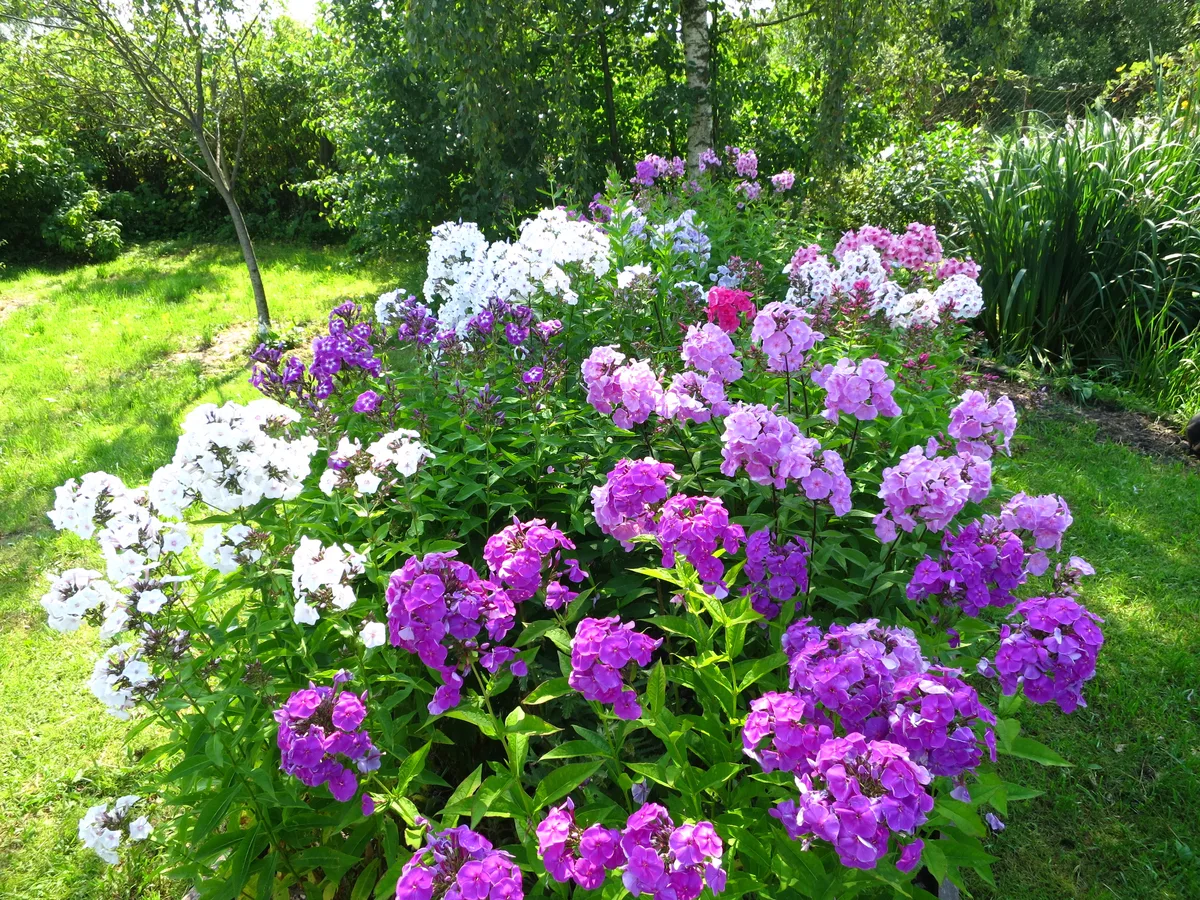
The blooms are fragrant and a favorite with garden pollinators from mid-summer until mid-fall. At their highest, garden phlox can reach three to four feet tall and stay upright all through the blooming period.
Since it’s a late bloomer, garden phlox will die back quite late in the season, so that’s when you’ll know it’s a good time to trim it back to about three inches above soil level.
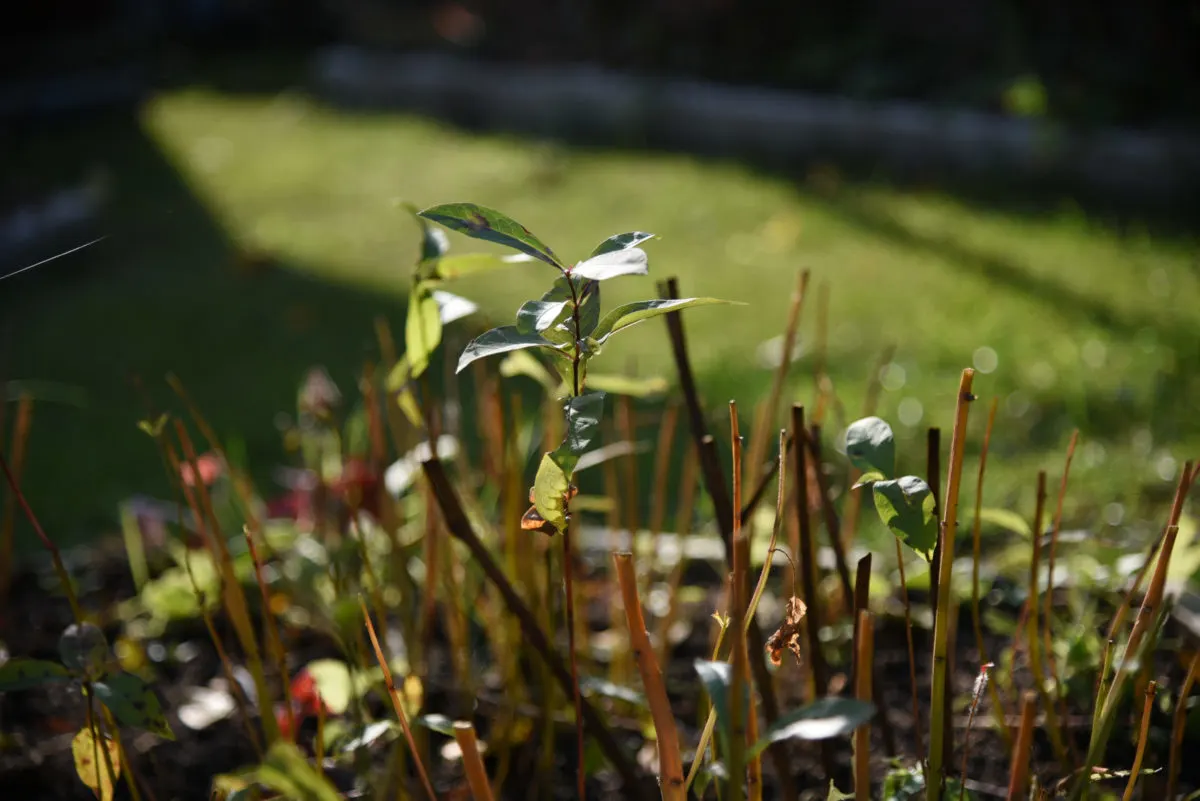
By the end of the growing season, tall phlox becomes susceptible to mildew, so you should dispose of all the prunings in the trash.
Moss phlox (Phlox subulata), also known as creeping phlox, mountain phlox or moss pink, is a different variety that doesn’t need to be pruned in the fall.
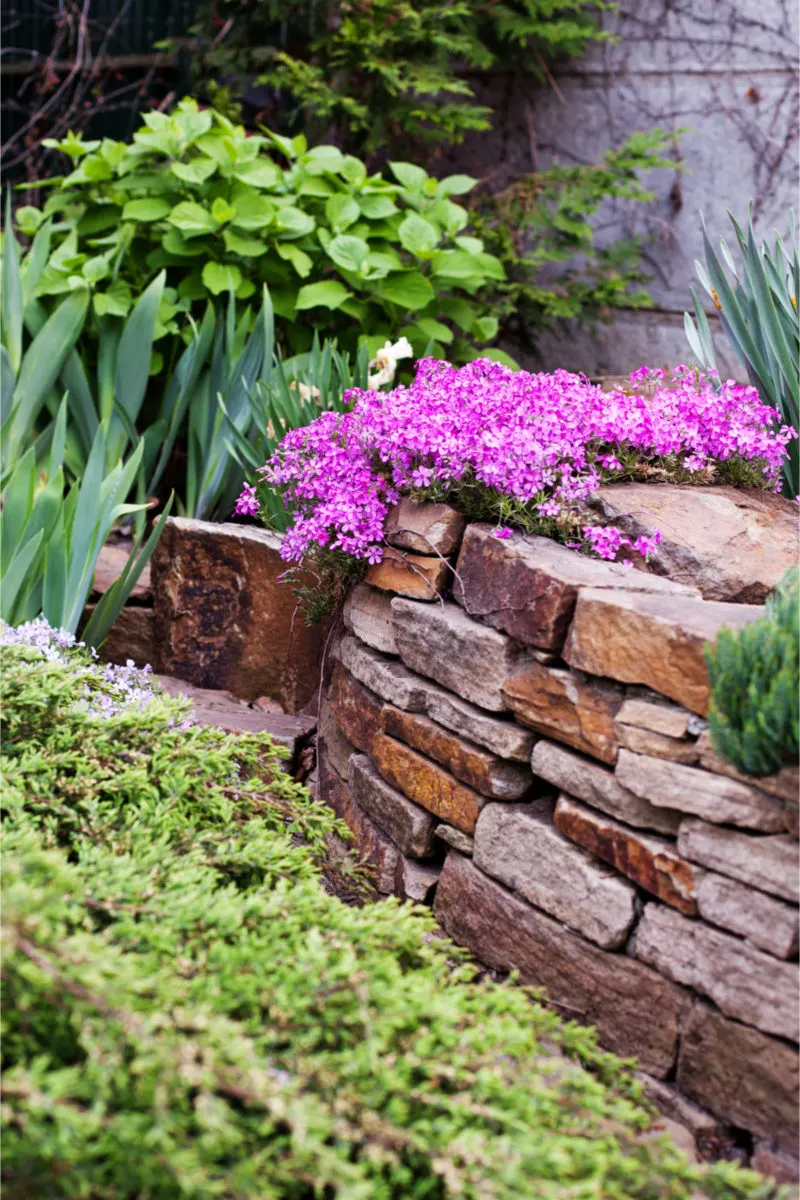
Moss phlox acts more like a ground cover, so it only grows to about three to five inches tall and forms a carpet-like structure in borders, flower beds or rock gardens. Unlike its tall counterpart, this variety is not usually affected by powdery mildew or other fungal diseases. It will keep its compact shape all through the winter and only needs a bit of tidying up in the spring to allow for new growth.
8. Catmint (Nepeta)
If your neighborhood cats haven’t had the chance to frolic through your nepeta and flatten it to the ground, then you might need to do the hard pruning yourself.
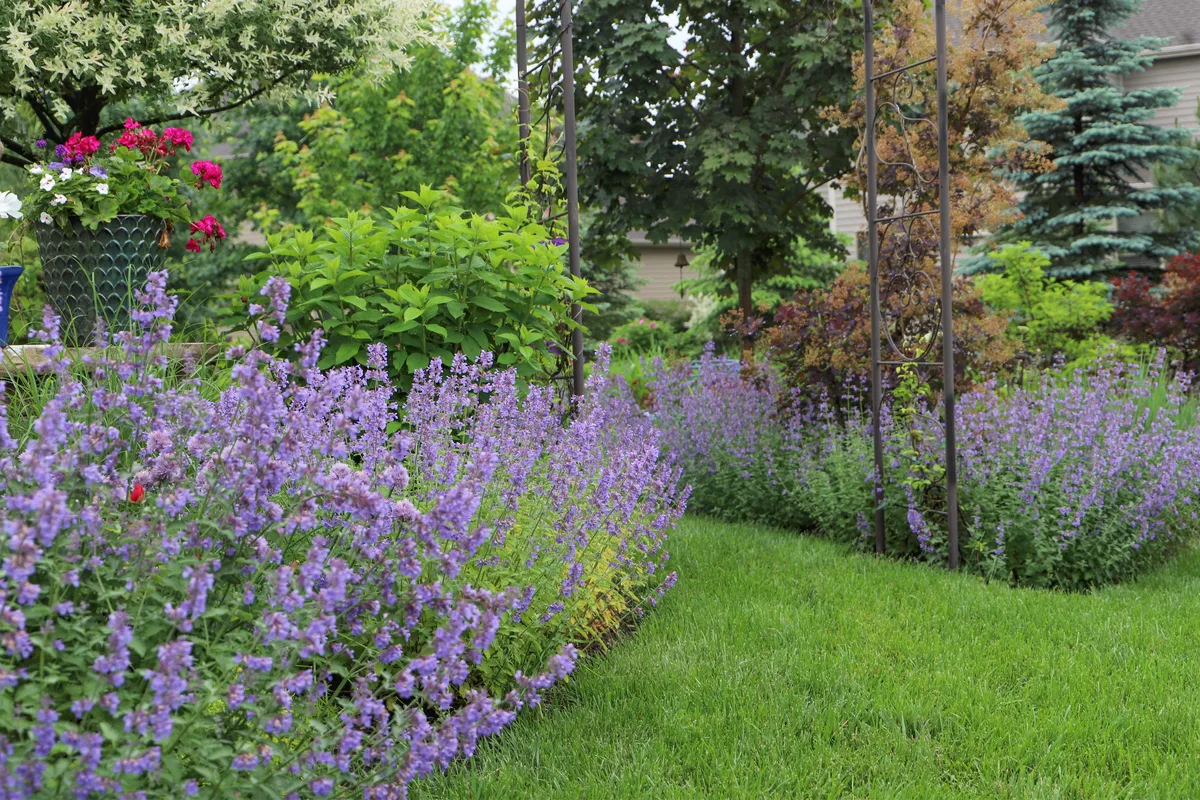
Catmint can be left to its own devices until late in the year. In most climates, you can wait until early winter to prune your nepeta. By that time, the plant will have become messy and ratty and the flowers will have faded to a washed-out gray.
Unlike most of the other plants on this list, nepeta will already start growing next year’s stems by the end of the year, so be careful when you prune it not to remove new growth. Trim back the yellowing stems while avoiding the grayish-green ones.
Overcrowded nepeta plants are prone to developing powdery mildew, so it’s best not to wait until spring to prune them.
Some taller nepeta cultivars will grow so tall during the summer that they’ll flop over other plants in the bed. If you’re growing one of the floppy varieties, you can prune it halfway down in mid-season. With a bit of luck, you may get a second bloom in early fall, especially if you have a long growing season.
Dwarf varieties (such as Nepeta x faassenii) have a compact growth pattern and should only be pruned in the fall.
9. Hollyhocks (Alcea)
Hollyhocks are a mainstay in the cottage garden, but unfortunately so is hollyhock rust which manifests itself as bumpy yellow and brown warts on the underside of the leaves. If your plants get attacked by this unsightly fungus, you’ll want no hollyhock foliage in sight by the end of fall.
Most hollyhocks are not true perennials, but biennials. This means the plant spends its first year getting established and growing foliage in order to bloom and produce seeds in the second year. Once it completes this cycle, the biennial hollyhock dies. Some varieties will flower during their first year if you manage to get a head start on the season by seeding them indoors.
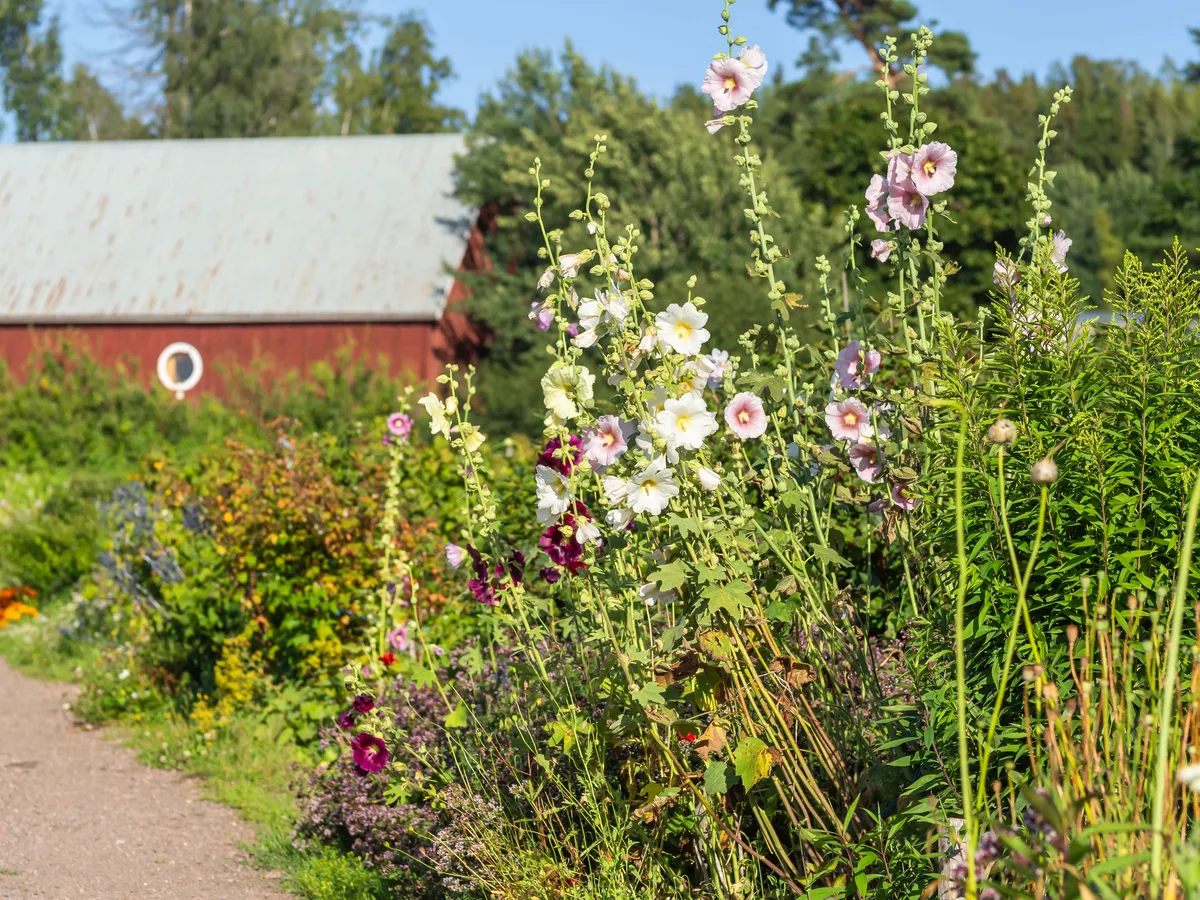
The fact that hollyhocks are not true perennials may come as a surprise if you’re used to your plants coming back in the same spot for more than two years in a row. Most of the time, a new plant will grow from self-seeded stock, giving the impression that it’s the same plant year after year.
This is why you should let your hollyhocks go to seed before pruning them at the end of the season. You don’t have to let it self-seed, of course, but you may want to collect the seeds until you have plenty to start anew every year.
Hollyhocks are mid-summer bloomers that last late into the fall in milder climates. They’re low-maintenance plants that aren’t very fussy (other than the aforementioned rust affliction), so all you need to do is cut them back to about five inches above the soil. You should dispose of the leaves, but you can scatter the seed pods for next spring’s cottage garden.
10. Japanese anemone (Anemone hupehensis)
If you’ve read our guide on how to grow beautiful anemones, you’ll know that Japanese anemones are the only type that blooms from mid-summer to late fall. You’ll also remember that you can overwinter them in place – unlike the other types of anemones that grow from corms (bulbs).
You should deadhead your Japanese anemones regularly in order to encourage bloom production.
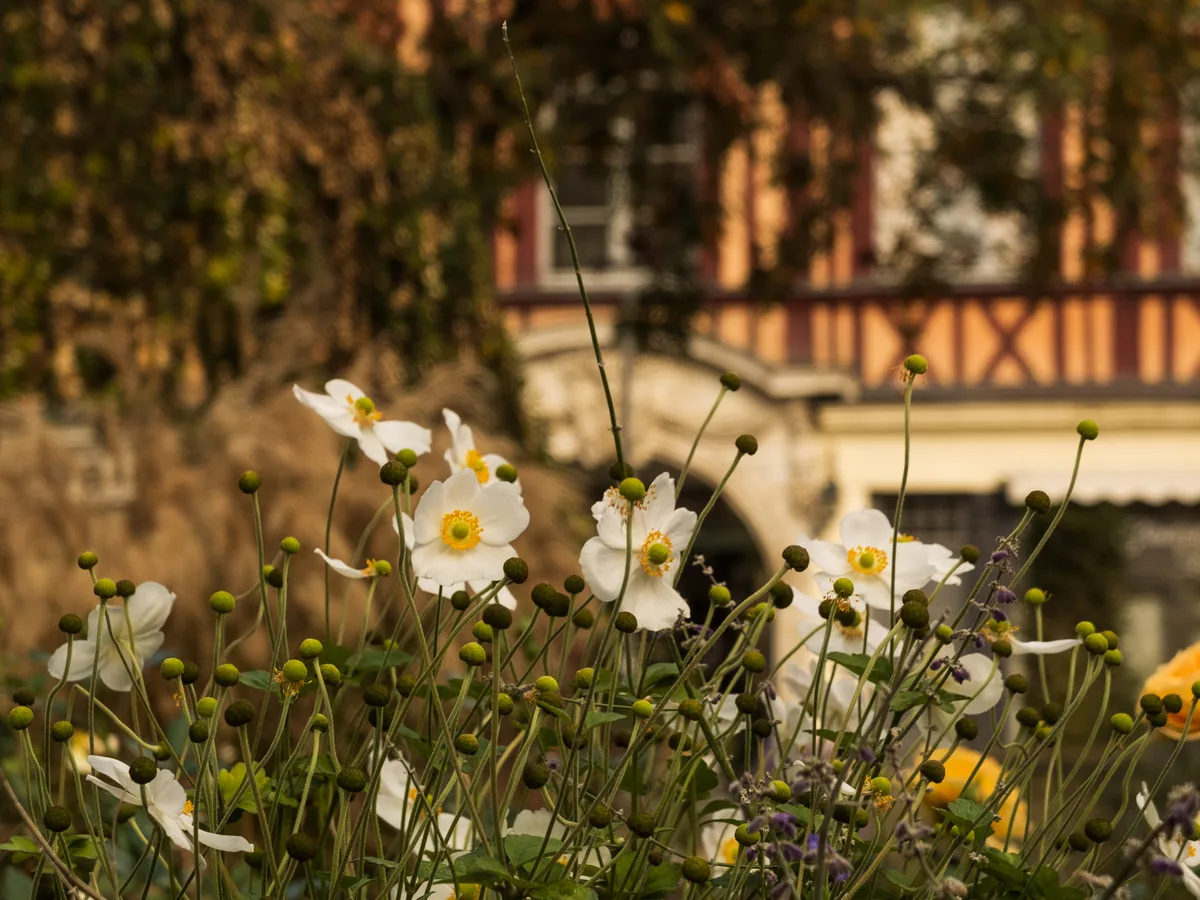
Japanese anemones have a long blooming season, so you might find yourself itching to chop them down before they go to seed. Considering the fact that it takes a while for these plants to get established, we recommend you let them self-seed or collect the seeds to get more plants started for next summer’s cottage garden.
Once the first frost hits, the foliage of the Japanese anemones will turn dark brown; once this happens you can cut it down to about four inches above soil level.
11. Yarrow (Achillea)
Yarrows are easy to get started, low maintenance and much-beloved by pollinators – the three attributes that are most desirable in a perennial plant. Yarrow also has a very pleasant fragrance and is considered by many an edible herb.
You may associate these plants with white flower beds, but they come in a few other colors and hues, such as yellow, pink, red, burgundy, peach and lime. In the fall, you can let the yarrow blooms self-seed or you can cut them off to preserve them as dry flower arrangements.
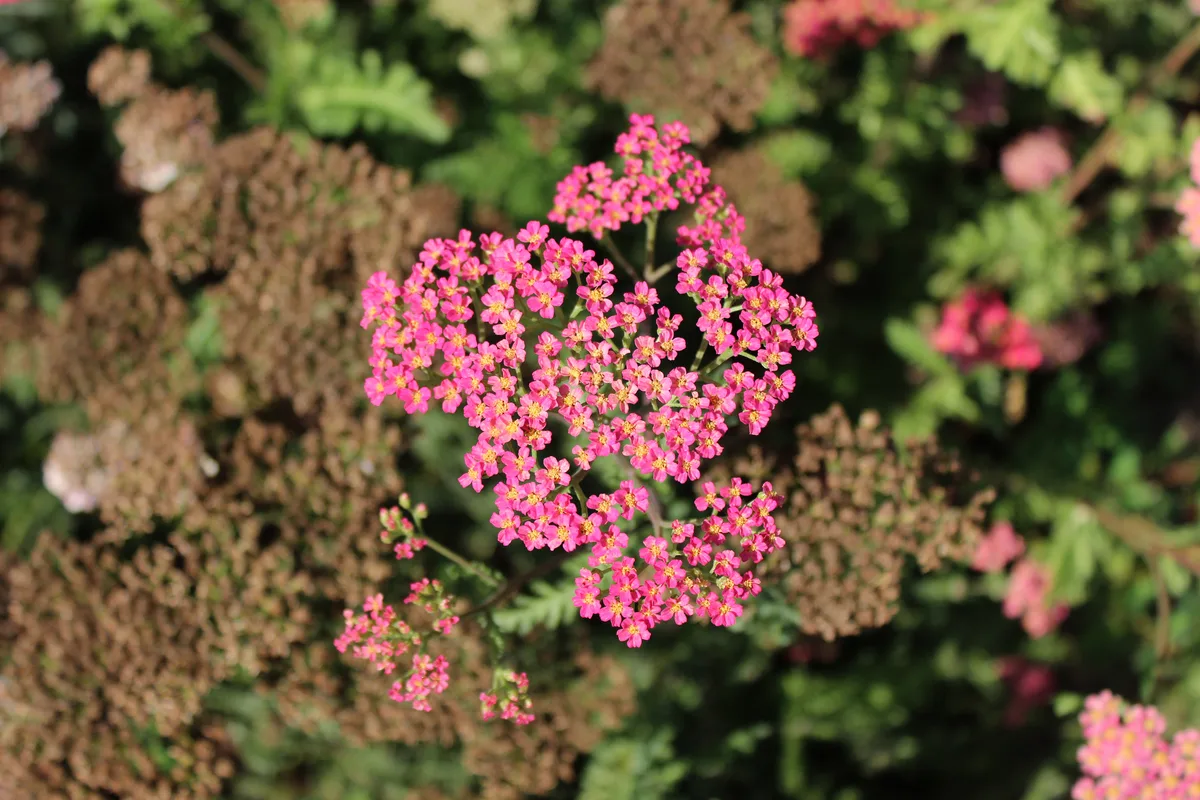
Think of yarrow plants as the class overachievers in your garden because they don’t wait for spring to start putting out new growth. Instead, they start putting out new leaves at the base of the plant late into fall. When you prune them in the fall, try to trim the old stalk down to the basal clump without interfering with the new growth. You can prune yarrow to a couple of inches above soil level.
12. Ligularia (Ligularia dentata)
Ligularia is a plant that should be more popular than it is. It has beautiful robust foliage (often the main attraction), grows well in the shade and puts out cheerful golden-yellow flowers that tower well above the oversized leaves.
The flowers of the ligularia don’t last too long, so they will die back way before the leaves do. Cut the dry flower stalk right at the base and just enjoy the lush foliage for the rest of the season.
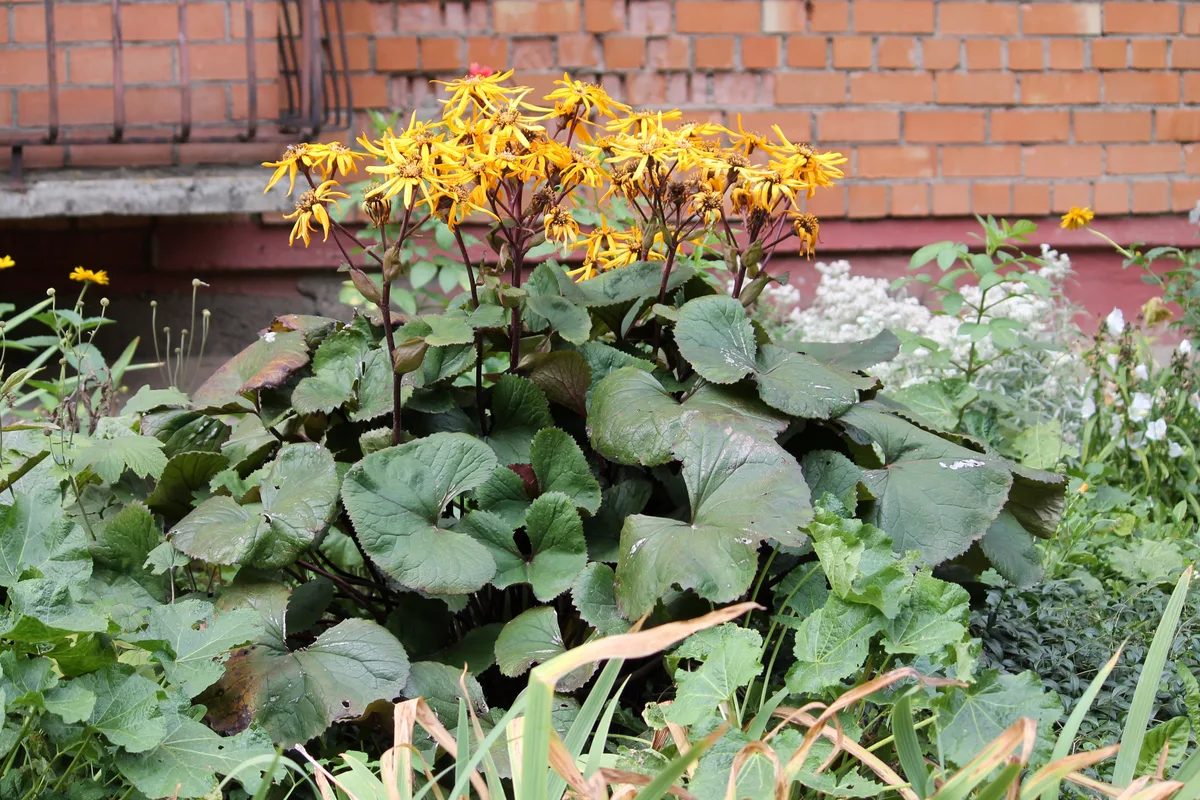
After the first frost, the foliage itself will turn brown and mushy, so time to grab your secateurs and chop away the leaf stalks as well. Just like hostas, the leaves of the ligularia are delicious snacks for snails and slugs, so keep an eye out and remove their eggs when you clean up the plant in the fall.
This is, by no means, a comprehensive list of plants that you should prune back in the fall. As a (very) general rule, if the stalks and the leaves of the plant keep their shape after the first frost, you can leave the pruning to spring. But if the foliage turns mushy, then it’s safer to prune it down in the fall.
